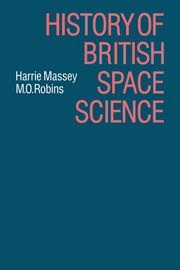Book contents
- Frontmatter
- Contents
- Glossary of abbreviations in text and annexes
- Glossary of abbreviations in appendices
- Preface
- 1 The scientific background
- 2 The technical background
- 3 The initiation of the Skylark rocket programme – the IGY and artificial satellites
- 4 Post-IGY developments – NASA – COSPAR – British National Committee for Space Research – British satellite experiments
- 5 The Ariel programme
- 6 The European Space Research Organization
- 7 Commonwealth co-operation in space reseach
- 8 Smaller rockets for scientific purposes – Skua and Petrel
- 9 Attitude controlled Skylark rockets
- 10 The Trend Committee and the Science Research Council
- 11 The transformation of ESRO into ESA
- 12 The Space Science Committee for Europe
- 13 Scientific studies by British space scientists – figure of the earth and the neutral atmosphere
- 14 Scientific studies by British space scientists – the ionosphere, the magnetosphere and cosmic rays
- 15 The contribution from British space scientists to astronomy
- 16 Concluding remarks
- Appendices
- Annexes
- Notes
- Index
5 - The Ariel programme
Published online by Cambridge University Press: 05 February 2012
- Frontmatter
- Contents
- Glossary of abbreviations in text and annexes
- Glossary of abbreviations in appendices
- Preface
- 1 The scientific background
- 2 The technical background
- 3 The initiation of the Skylark rocket programme – the IGY and artificial satellites
- 4 Post-IGY developments – NASA – COSPAR – British National Committee for Space Research – British satellite experiments
- 5 The Ariel programme
- 6 The European Space Research Organization
- 7 Commonwealth co-operation in space reseach
- 8 Smaller rockets for scientific purposes – Skua and Petrel
- 9 Attitude controlled Skylark rockets
- 10 The Trend Committee and the Science Research Council
- 11 The transformation of ESRO into ESA
- 12 The Space Science Committee for Europe
- 13 Scientific studies by British space scientists – figure of the earth and the neutral atmosphere
- 14 Scientific studies by British space scientists – the ionosphere, the magnetosphere and cosmic rays
- 15 The contribution from British space scientists to astronomy
- 16 Concluding remarks
- Appendices
- Annexes
- Notes
- Index
Summary
In the previous chapter an account was given of the events which led to the establishment of a co-operative programme in which, in the first instance, the National Aeronautics and Space Administration (NASA) would launch three satellites at roughly yearly intervals with British scientific instruments aboard. We now describe in more detail the nature of the programme and how it worked out in practice. Most attention will be concentrated on the initial three satellites but something will also be said of the three further satellites whose launching was arranged at a later stage.
General co-operative arrangements
It was likely that a first launch for UK experiments would take place from the launch site on Wallops Island on the east coast of the USA. The arrangements with experimenters would be those normal in the USA. Each experimenter would have first call on his own data, and if the first launch attempt failed every experimenter could expect a second launch for his equipment. In return, NASA would require the equipment to have satisfied the stringent environmental tests appropriate to the launch and orbit conditions. In addition, evidence that the scientific instruments had operated satisfactorily in vertical sounding rockets would be required. If this was not possible in all cases using British rockets NASA would consider offering test flights in American rockets. Financial arrangements would be on a ‘no billing’ basis, each party paying for those items for which it was responsible.
- Type
- Chapter
- Information
- History of British Space Science , pp. 74 - 107Publisher: Cambridge University PressPrint publication year: 1986



